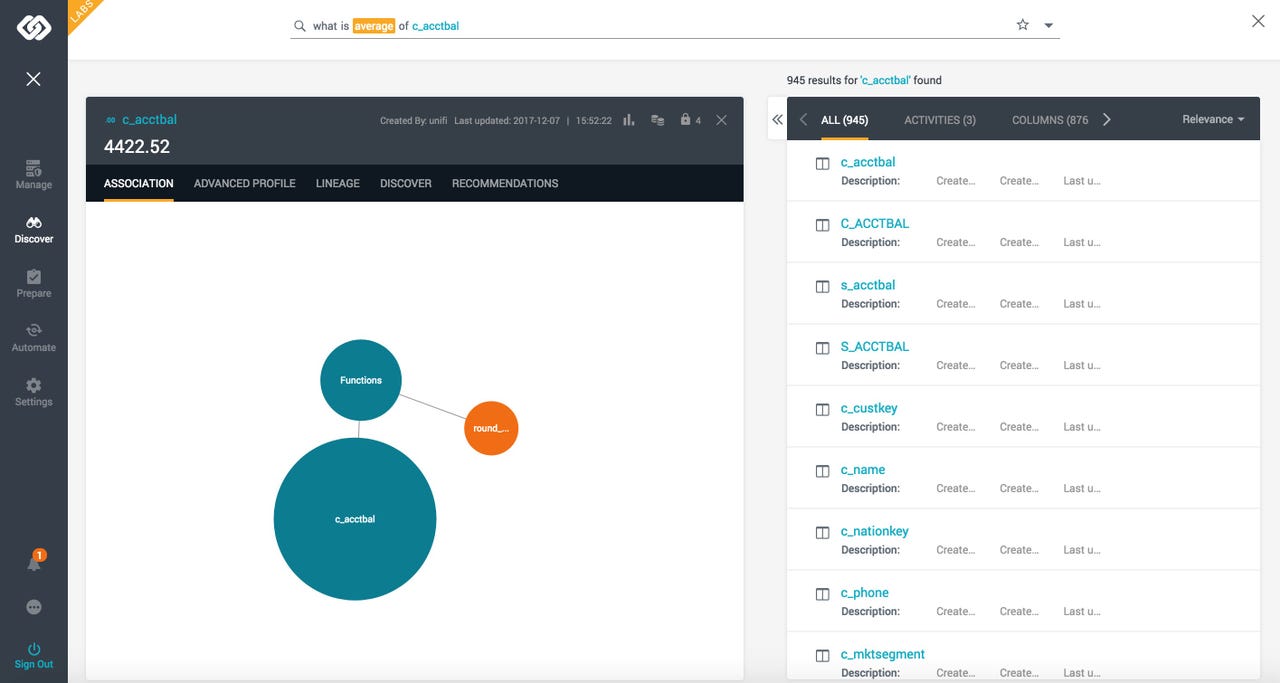Unifi Data Platform gets AI-assisted guidance with "OneMind"

2018 is bound to be the year of embedded artificial intelligence (AI), be it in the world of analytics, enterprise applications, IoT or elsewhere. And that makes sense because, just as with past technology innovations, from the graphical user interface, to Web services, social and even the Internet itself, the stuff that really catches on has to mature from being standalone and fetish-ized to built-in and useful.
I want my AI
In the case of the Unifi Data Platform -- which already spans multiple domains of functionality in the data analytics workflow -- AI and natural language processing (NLP) capabilities in the product, in the form of its new "OneMind" functionality, are being introduced today. The purpose of OneMind is to enhance self-service capabilities for analysts and business users and help them be of "one mind" with IT, some of whose proverbial pressures will ostensibly be alleviated because of the technology.

OneMind at work
Unifi's modules (or "pillars," as the company refers to them) include Governance & Security; Catalog & Discovery; Data Preparation; and Workflow & Scheduling. OneMind is implemented as a natural language-driven recommendations engine that surfaces within each module and aids the transition between them.
The more the product is used at a customer, the more the product learns about that customer's usage patterns and, through observation, the more contextual information it gets about how different data objects and entities are related. The observations and derived learning are codified in a "knowledge graph" which, as with most good AI engines, is perpetually improving itself and perfecting its understanding.
Guided tour
An analyst might start by querying the data catalog, merely typing in the word "campaign." Unifi would then return results, listing various data sets that match the search term. Upon selecting one, the analyst can profile the data and is prompted to create a (data) transformation job. Further recommendations are then provided to help the analyst perform such tasks as joining data sets (utilizing "OneClick joins"), enriching the data (with "OneClick functions"), choosing columns, adding filters and aggregating the data.
Features like OneClick functions reduce keystrokes, and friction, for the analyst
Back at the beginning of the process, metadata queries deeper than simple keyword searches on data set names can be performed. For example, an analyst could type in the query "show me the metadata of c_mktsegment" or "what is the description of spend_level." In addition, object association, data profiling, lineage and other information can be visualized in response to a query. Even calculations can be performed, with a query like "what is the avg of c_acctbal." As these queries are typed in, OneMind offers a dropdown list of suggested terms to complete the query. Analysts who have used the Q+A feature in Power BI will feel right at home here -- and that's probably not accidental.
It's assistance, not magic
To be clear, OneMind's recommendations don't always seem AI-driven...some of the prompts offered are more Wizard-like than anything, providing shortcuts or "speed dials" to help analysts navigate from one pillar of the product into the next. It might be useful to think of OneMind as a "valet" or a "concierge" experience that combines NLP, AI and rule-based guidance to make the product more user-friendly and to make its functionality more easily discoverable.
OneMind will not replace data scientists and engineers. What it will do is give power user analysts greater ability to do more of their own discovery work, with less friction. In some cases, it will make things faster and easier; in other cases it will evangelize capabilities of the Unifi Data Platform and, hopefully, get analysts more exited about what they can do with their data.
But I have two caveats to that perhaps skeptical analysis: (1) usability features are absolutely legitimate investment areas in product development, as they enhance value for the customer and (2) there is real NLP and machine learning technology at work here, making this OneMind release a bona fide down payment on bringing increasingly comprehensive domains of AI assistance to the product. This seems like a prudent course to pursue.